Lean Innovation with Kathy Fish of P&G
Lean Innovation - Untold Stories of Innovation
“Fall in love with the problem and consistently check back with the consumer to make sure that the solution that you're providing is really a painkiller in solving their problem in a meaningful way better than anything else that's out there.” -Kathy Fish, Chief Research, Development and Innovation Officer at Procter & Gamble
From today’s episode you’ll learn:
Why do stories matter to the innovation process? What values can be instilled in innovators who share stories? How do innovation leaders inspire creators to tell and share their success and failure stories?
We talk with Kathy Fish, Chief Research, Development and Innovation officer at Procter & Gamble. We learn that this 182-year-old organization—the largest branding company on the planet—adopts a startup mentality when creating new growth opportunities. Leveraging lean innovation allows P&G to deliver superior experiences and disruptive technologies. In her experience, telling stories about past innovation processes inspires organizations to take on these difficult challenges. Not only do stories shape company culture at P&G, but they drive products to success. In this episode, Kathy shares example innovation stories from two successful P&G products: Pampers Swaddlers and Always Discreet. Kathy tests out product stories with friends and family before an invention is ready for the shelves. If they wouldn’t go out and buy it, she encourages the team to go back and sharpen the story.
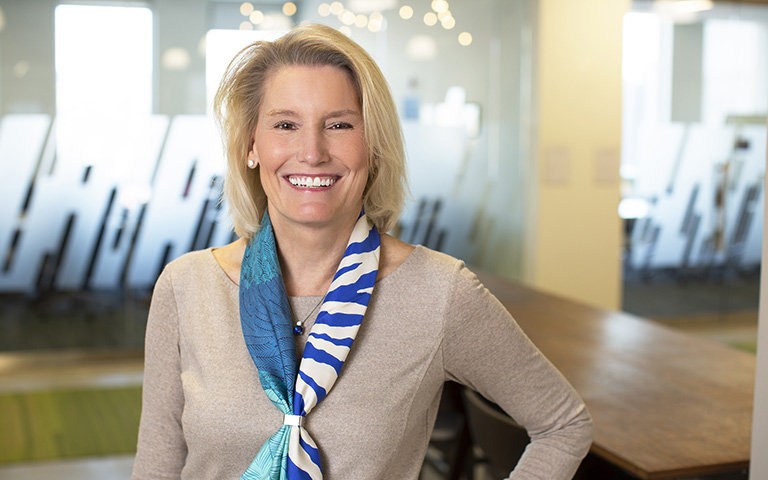
Kathy Fish is the Chief Research, Development and Innovation Officer at the Procter & Gamble Company, leading the Company’s innovation program and strategy; its nearly $2 billion annual investment in R&D; and over 7,000 global R&D employees. Kathy is a member of P&G’s Global Leadership Council and liaison to the Board of Director’s Innovation and Technology Committee. As the first female in her role and passionate about the importance of diversity to innovation, Kathy fosters an inclusive environment where women can excel in technical disciplines. Kathy is also an executive sponsor of P&G’s Asian Pacific Americans affinity group.
untoldcontent.com/trainings/innovation-storytelling-training
TRANSCRIPT – Lean Innovation
This episode, Lean Innovation is powered by Untold Content’s innovation storytelling training. Increase buy in for your best ideas in this immersive and interactive, story-driven experience. Where your teams refine storytelling techniques for their latest projects, prototypes and pitches—and get inspired by 25 epic examples of impactful innovation stories. Learn more at https://untoldcontent.com/innovationstorytellingtraining-2/.
Katie: Welcome to Untold Stories of Innovation, where we amplify untold stories of insight, impact and innovation. Powered by Untold Content, I’m your host, Katie Trauth Taylor. Our guest today is Kathy Fish. She is Chief Research, Development and Innovation Officer at Procter & Gamble. Kathy, thank you so much for being on the podcast.
Kathy: It’s great to be here, Katie. Thank you for inviting me.
Katie: Can you share with us where your personal story of innovation began?
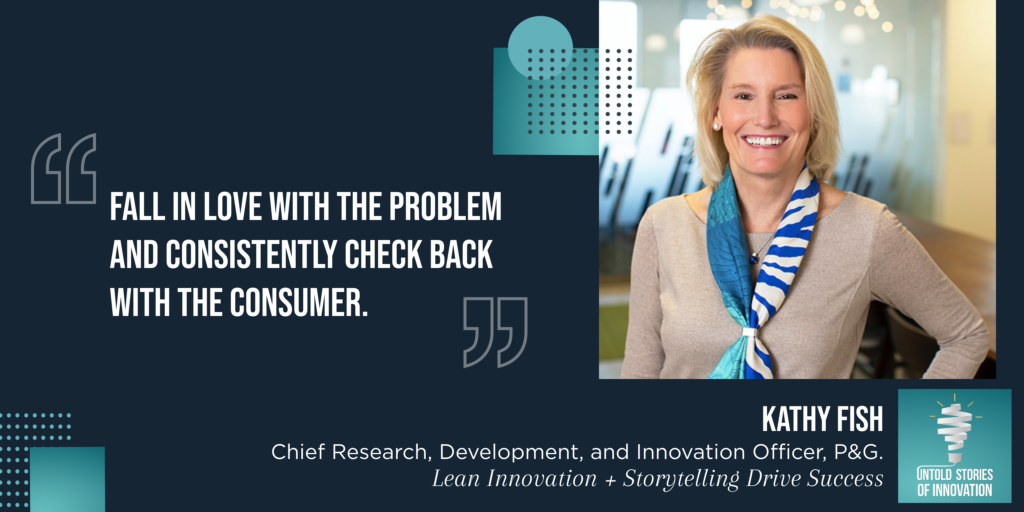
Kathy: You know, I just loved math and I really liked science, too, in high school. I went to college thinking I would major in math but learned pretty quickly that it was more theoretical than I liked. And in my classes, I met a lot of people going into chemical engineering, learned about the possibilities to solve real problems and real challenges in the world. I had a pretty bad internship where I learned what wasn’t a good fit for me. And then during my senior year, I got to meet Procter and Gamble on campus. And it was so inspirational because the individuals I met were so committed to improving consumers’ lives every day, which is the mission of P&G. Today we serve five billion consumers every day, so we have a lot of opportunities to do that. And then as I started, I was really lucky early in my career because I got to work on two really big breakthrough innovations for the company. And while I was pretty new, I got to learn a ton from people who were true innovation leaders. The first one was liquid Tide, where, believe it or not, liquids were very small in the market at that point in time. And we did not want to put the Tide name on a liquid unless it gave performance that was worthy of the Tide name and that required a lot of breakthrough innovation.
Katie: Wow.
Kathy: Yeah. And of course, liquids are the dominant form today.
Katie: Yes!
Katie: Yeah. And then another one. Then I got the fortune to work on two-in-one shampoos. And it’s really hard to clean the hair while you’re depositing conditioning on the hair. And, you know, people had been working on that for over 40 years. One of our scientists figured out how to do it. And that took us from being a pretty small player in the haircare space to having the number one brand, Pantene, and the number one shampoo, Head and Shoulders. So just a really, really great learning journey on what it takes to do innovation that is truly breakthrough. And I’ve tried to carry that learning through for the rest of my career.
Katie: It’s incredible to think about some of the ways that industry is self-disrupted. Really. And could you share with us how you decided on a leadership track at Procter?
Kathy: Well, believe it or not, again, there was no technical track when I first started. So that was a really easy decision, but I would have made the same decision today. Our technical track was started around 1990. Just recognizing that the inventors who create our truly breakthrough innovations are so valuable to the company, and they aren’t always natural leaders of big groups of people, but they are really leaders from an innovation standpoint. So the reason I would have gone with the management track, though, is I love connecting innovation strategy to business strategy. I love helping to set a vision for the organization and inspiring people with what we need to go do. You know, I love helping break barriers for the organization as they do it. And probably I wasn’t good enough to be one of those highest levels.
Katie: I sort of doubt that.
Kathy: On the technical track either.
Kathy: Well, that’s a very humble perspective to hold. So I’d love to hear then—now that you are in such an important, critical role in the organization, what do you believe about the role that storytelling plays in innovation?
Kathy: It’s such a great question because we believe that our products need to be functionally superior. That’s sort of the foundation of what we do. But we also really need to create a very holistically crafted experience for the consumer to make an emotional connection, so we get the full benefit of the innovation that we’re doing. And I had an experience about 20 years ago where the baby care organization that I was in at the time was investing in innovation design and bringing design thinking into the organization. And I saw how powerful that was. And we, as a result, have made a big investment at P&G in innovation design in our R&D organization. And what we do there is we get really clear on the desired consumer experience, which is both functional but also very emotional. And that becomes sort of the vision or the lighthouse that we’re shooting for. And it may be something that takes 5 to 10 years to fully get to, but it becomes kind of a guiding light for the organization. So let me just share a story that maybe brings that to life. My first experience was on Pampers Swaddlers. Swaddlers is our newborn diaper and what we learned—
Katie: Yes, of course, I’m very familiar. I have three little ones at home.
Kathy: Ah! I hope you use Swaddlers.
Katie: We definitely do. Yeah, it’s true. They really are—they’re the only thing truly that can get—as my children were very young, that was the only diaper that would work through the night. You know, I’d wake up and they’d be dry and I wouldn’t have to wake up again. It was great.
Kathy: Good. Well, that’s the core functional benefit we’re shooting for. But the desired consumer experience was actually to swaddle my baby in comfort and security.
Katie: Yes.
Kathy: And that’s what every new mom wants to do. So we were able then to think both about how do we communicate with the consumer and make a connection in that really emotional way? And then importantly, what features did we want to put into the diaper? So having a very soft outer cover was important. Of course, the functional benefits that you talked about around dryness, so the baby could sleep through the night. A wetness indicator, so mom knew when she needed to change the baby. Overlapping fasteners that would help make the diaper more secure. An inner lining that helped pull B.M. away from the baby’s skin to keep his or her skin very healthy. So that was a lighthouse. It took us over 10 years to get there. But by starting with clarity on where we wanted to go, we were able to make sure that every step the organization took on the journey was moving in that direction. And we were able to start building the business in a very good way in the short term while we worked to get to our long-term goal.
Katie: You know, something we talk about in our innovation storytelling workshops and in some of the research that we’ve collected in this space is the difference between a story-led innovation and an innovation-led story. So sometimes an innovation occurs and it’s sort of a surprise discovery. And then you have to kind of come up with the storyline that will help make it make sense to other people. But in this case I love this example of Swaddlers. It seems to me that’s a story-led innovation, where you’re starting with a deep understanding of what the consumer is desiring, which is that swaddling and comfort and security. And from there, you’re able to innovate against it. And it may take a long time to get there, but your story holds true throughout. Is that correct?
Kathy: I think that’s exactly right. And I think ideally we would always start with the story. I think, in reality, our innovation process is a marriage of what’s needed and what’s possible. And sometimes we get inspired by what’s possible from a technology standpoint. And that leads us to actually create better stories.
Katie: Yes, absolutely. Yeah. I think it’s really not necessarily that one is always prominent, but that both can play a role. And it’s interesting to, kind of, just know going into an innovation brief which kind of scenario you’re working with. That way you can use different storytelling strategies, honestly. It may take a little more work if it’s an innovation-led story to remember that story is still important. And to pull from it as you still play with technology and think about what’s possible.
Kathy: Absolutely.
Katie: So tell us, can you share—I love that example. Do you have other stories, innovation stories, you could share?
Kathy: Oh, we have lots of different innovation stories. So I think a really good one for us more recently was our entrance into the adult incontinence category, where the desired consumer experience for the woman is to be protected but to also be very discreet. So as we worked on Always Discreet—and let me add to the desired consumer experience. To continue to feel feminine and to feel pretty. So as we started Always Discreet, we learned that only one in nine women use an adult incontinence product. But actually, one in three women have some sort of problem.
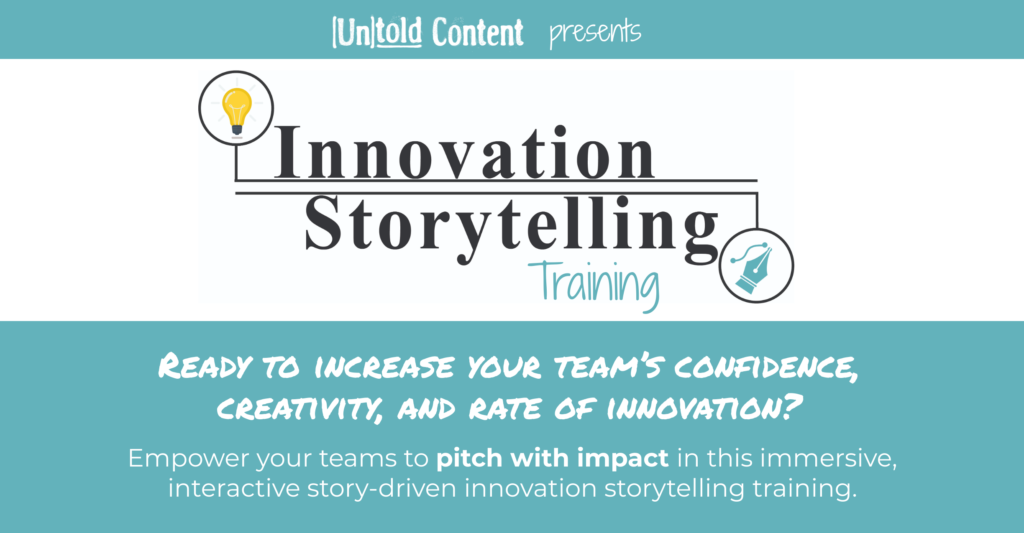
Katie: Interesting.
Kathy: Yeah. And by normalizing the issue and by providing a solution that is more discreet and allows you to feel pretty, we’ve gotten that number to about one in five people. So we’ve really grown the category in a meaningful way, and I think really helped women along the journey. So we made great protecting products that were thinner. That was the discretion. We also worked on odor control, which is super important. But then we brought in lingerie designers to help the organization really think about, how do we make this more like underwear?
Katie: Yeah.
Kathy: And we launched a product called Always Discreet Boutique, which, you know, several consumers told us was pretty enough that they would put it in their underwear drawer. And it really did help them feel feminine. So it’s been a great step on the journey. And, again, getting clear on what that desired consumer experience was helped us really focus the R&D organization on what’s most important.
Katie: Absolutely. There’s something about that, too, that speaks to the responsibility of an organization like Procter to show the consumer what is possible. Because perhaps the consumer knew that they didn’t—you know, that they felt embarrassed or wanted to be discreet or they didn’t really like the look or feel of the products that were existing. But they may not have dreamt that that sort of product could make them feel that way or could be that pretty. And so it’s—
Kathy: And it’s really—when you talk to women who are struggling with the challenge, it can really change their life. Like they stop going out because they’re afraid of accidents and being embarrassed. So providing solutions that, first and foremost, really work. But then also addressing the other challenges is really life changing for those women and super important.
Katie: Yes. Can you share with us—you know, we could talk a lot about the importance of storytelling to the innovation itself and how it gets created. But what about sort of at the individual or the team level inside your organization? Can you share with us your thoughts on effective innovation storytelling internally and why that matters?
Kathy: Well, I think the reason it matters is because it drives alignment on what needs to happen. And so, you know, for our organization, they get really motivated by our purpose of improving consumers’ lives every day. And that actually is an incredibly high bar for innovation. You know, it’s more than just adding a new sense line extension, which is nice to have. But it’s not necessarily solving a real problem. So as people are working with consumers and they’re seeing that they’re solving real problems in their lives and making a difference, it’s super meaningful. But the stories help us get alignment on where we’re going to go. And everybody gets an opportunity to contribute to what that story is, but then once you have it, it really directs the effort and keeps people very focused.
Katie: Can you share with us some of the, sort of, ways in which story is embedded into your innovation process? So how does it change from the seed of an idea forming compared to maybe it’s entering the stage gate or it’s moving along to scale up? How does storytelling kind of change in each of those moments?
Kathy: You know, early on, we’re usually starting with leading-edge consumers. You know, we usually say the future is here. It may just not be big yet. And so if we can find consumers who are on the leading edge and do this design thinking work to really get to what are the challenges that they have in their lives, as their lives are changing and that technology opens up a possibility for us to solve. As we’re having those conversations, we start to create fairly big stories. Like, you know, we get a lot of richness, a lot of data. And then, you know, our reality is we need to get super sharp over time. We don’t have a lot of time to communicate to the consumer. They’re not going to go study about our products. We have to—as we move through the stage—as we enter the stage gate process and move through getting ready to launch, we need to have something that really is a surprisingly obvious idea that brings to life the problem that we’re working to solve and also brings to life why the product that we’re offering is better than anything else that’s available. So we take that richness around the desired experience and all we learn with consumers at the beginning and we continue to sharpen it as we develop the proposition.
Katie: I love something you said at the very beginning, and I want to dig into it a little bit more. You said you collect a lot of data and you hear stories in that data. Could you speak a little bit more to data storytelling?
Kathy: Well, we—as we’re looking at taking on spaces where we want to innovate, we again are starting with how the consumer’s life is changing and what new problems that’s opening up for us to solve. And we’re also looking at how technology is changing and what opportunities that’s opening up. And as we’re starting to look at these spaces where we might want to innovate, we’re looking at all sorts of data: what people are doing today, where startups are investing and innovating, what problems people say they have today, what we observe when we watch them today. And we—so we’re looking at data from all sorts of different sources and that helps us really assess. Is this really a big problem? Is it something that really matters a lot? Or is it more of a nice-to-have? We’ve been really working to bring lean innovation into our organization, and one of the core tenants of that is keep the consumer at the center. Be sure you’re really clear on the problem you’re solving. And then also make sure it’s a—that your solution is really solving that problem. It’s not a vitamin. It’s really a painkiller. So your solution is truly a painkiller and really makes a big difference.
Katie: Yeah. I think that speaks to the role that impact really plays in any innovation story. So how do you assess impact when you’re listening and deciding and supporting your other leadership in deciding what to greenlight and what to shelve?
Kathy: Well, we are moving to be much more experimental and much more data based, using lean innovation approaches. So I guess what I mean by that is we, historically, have used a lot of attitudinal research. And that still has a place to help us screen ideas that seem like they have a lot of potential from things that really don’t. But we ultimately want to get to behavioral-based research either through like a direct to consumer learning, where we see if the consumer is really willing to buy our product or maybe going to a few stores and getting learning that way. And sometimes we start just with the concept. We actually don’t have the product available, but we take the consumer that far to see if they’re willing to pay. And then we say, sorry coming soon. And sometimes we do have the product available. But that way we’re not having the leaders of the organization decide what’s really important. We are using, you know, an experimental approach to let the consumer tell us what’s really important.
Katie: Yes, absolutely. I was introduced to lean innovation back when I was first—actually, when I started consulting. I was working in the US Department of Veterans Affairs and working with systems engineers who were deploying lean process improvement to try to, you know, decrease veteran wait times during the access crisis. And it was incredible to see how that could transform our healthcare system, whose systems in many ways were overburdened and weren’t necessarily lean. And then when I formed a startup and learned more about the lean startup methodology and that part of things, it’s so important to be thinking about how to get rapid feedback and to really listen and form your—allow your story to change and be agile as you move through the process. And especially as you’re getting feedback from consumers throughout that sprint or that lean approach that you’re taking.
Kathy: Yeah, very much. I mean, we are—you know, obviously we’ve been around for one hundred and eighty-two years. And we have a lot of businesses that are over a billion dollars. And so, you know, there’s—a lot of people don’t believe that big companies can change the way they innovate. But what we started with is, as we’re creating new growth opportunities, we want to behave more like a startup and learn with that kind of agility. And as you do that, we’re finding that we can often co-create with, you know, a small group of target consumers—say 30 to 50 people. And, you know, both qualitatively and quantitatively get a lot of feedback that helps us strengthen both the product and the story that goes along with it. And it gets really rich. And you can tell with that group when you get to a place where they really love your solution and it’s making a meaningful difference in their life. And we’re finding if we get that kind of emotional connection, that we move to the next stage of getting larger scale data before we really scale something. We’re often finding that we validate it. So it’s pretty powerful. And then I would also add that all that we’re learning as we’re creating these new growth opportunities is helping us be faster on our core businesses, where we can’t take the same level of risk, but we can learn at a much faster pace and we’re applying that and seeing that to be powerful as well.
Katie: What does that kind of lean innovation and design thinking actually look like at a pragmatic sort of process level inside your teams?
Kathy: So we have we call it growth works because we’re focused on creating new businesses that drive significant growth. And what we’ve done is in each of our business units—we have 10 business units—we have a growth board. We actually have a whole process. So starts with the growth board. And that growth board is like a venture capital board almost. So they use—they work with the teams to say, you know, tell me what you’ve learned, how do you know what you need to learn next, and how can I help you are their four key questions. And they decide how much funding to give the team, just like a venture capitalist would. So that’s the overlying structure. And then underneath it all, we have small, dedicated, multi-function teams. So historically in Procter & Gamble, we would do a lot of work in R&D with a little bit of help from our multi-functional partners, but very R&D focused. We’d even get into, you know, scaling up the product to make sure the cost was right before we would get heavily into marketing it. And then if you have the proposition right, it’s great. But, you know, often you find that you don’t have it quite right and you have to go back and do a rework and that’s slow and expensive. So what we’re doing now is we’re bringing these small multi-function teams, three to five people, always commercial representation and technical representation and then others, depending on what the key challenges that you’re facing. And that group works together on the consumer, understanding the product and the business model. So call it the story, the product, and the business model all at one time because all ultimately have to work. And, you know, we work to make sure we get problem validation, solution validation, and business model validation before we really double down and put a big team on it and start incubating a real business. And it’s quite powerful. We’re learning a lot about how to be much more agile and you can be much more agile by spending the time upfront to get clarity on the problem you’re solving. And then by having the discipline to say, OK, this is a new space. Our knowledge is actually low. We have hypotheses and assumptions which are high. Let’s get clear on the biggest leap of faith assumptions that we have and let’s focus our energy and effort on learning against those in the smallest and fastest possible way. So we’re learning a ton about how to do that.
Katie: That’s incredible. Thank you so much for sharing that. It really paints a vivid picture of how you make that happen. Could you share some of the challenges that teams are facing, especially around getting the story of the innovation right in those multi-functional teams?
Kathy: There’s lots of challenges just because, you know, we’re all set up as a big company to scale innovation. So just as you’re learning with the consumer, you know, our systems just aren’t set up to do that in a small way—to sell in a small way. But from a story standpoint, I think this really enables the teams. I mean the challenges are more about, how do we learn fast? And we’re figuring that we learn fastest by doing a lot of direct to consumer digital learning. And that really requires us to do what we call hands on the keyboard, which means that we personally own the interface with the consumer and we make the changes to the website in terms of how we’re advertising the innovation ourselves versus working through agencies. And that skill is called performance marketing. It’s very—you know, it’s a well-known skill in the direct to consumer world, but that’s not our core business. So we are learning how to do that very rapidly. We have some people who are getting very strong at it and we just need to develop more muscle there. And that is how you optimize the story very fast.
Katie: Yes. Because you’re learning in real time, right?
Kathy: Yes you are.
Katie: Incredible. So, you know, one of the other challenges we sometimes hear, especially among scientists or designers, is the sort of difficulty sometimes extracting themselves from the data or being able to see the story through the data. Do you see that kind of challenge, too?
Kathy: Well, yes. I mean, we do definitely at times fall in love with our solutions and lose track of the problem that we’re trying to solve for the consumer. And so it’s always really important to come back and, you know, if we get data that says, huh, we’re not doing what we thought we were for the consumer to really open our minds to challenging why not. And do we need to go a different direction with the technology or the solution that we’re providing? And that’s hard for inventors to do. Often their technologies are their babies. Right.
Katie: Yes.
Kathy: They have a lot of ownership around that. But the discipline that comes or the idea of falling in love with a problem is really helping us do that better. We also have a group in Procter & Gamble called Products Research. And their job is to really understand the consumer and the problem. And then to work with our technologists to translate that into what’s required to have a winning product solution. And we’re unique in having that versus most of our competitors. And we think that’s a real basis for competitive advantage because it makes sure that we—not saying we never get off track—but it is a good way to make sure that we’re staying focused on the consumer.
Katie: Yes, definitely. I’m thinking those multi-functional teams is another differentiator because it’s so important to have marketing and operations and design working together alongside one another to innovate against those problems.
Kathy: Absolutely.
Katie: I’d love to speak about culture. Can you share, especially in your role as a leader—storytelling. It plays such a key role in how you instill cultural values and work ethic inside of the people. You’ve already mentioned quite a few values in this. Like, you know, certain ways of thinking that you’re trying to instill. Can you share how you leverage storytelling to create the culture of innovation that you’re looking for?
Kathy: You know, as I came into this job, one of the discussions we had is that your culture really is the stories that you tell. And we always say at P&G that innovation is our lifeblood and it is. We win when we’re on the leading edge. So let’s tell some really big innovation stories to inspire our organization to take on these challenges that are really difficult. So we went back and we looked at—we made four stories on some of our biggest innovations. And we showed people how innovation isn’t really a straight line. It’s usually two steps forward, one step back. Sometimes it’s four steps back.
Katie: Yes.
Kathy: You know, there is a lot of risk involved because these disruptive technologies, which are the biggest value creators for us, are big investments in R&D and capital to industrialize and marketing to commercialize. So, you know, it’s a big risk if you don’t get it right. But telling those stories, so people understood that if they fail along the journey, as long as that’s really good learning, as long as we’re being disciplined about our experimental design and learning, that’s OK, because that is part of the innovation process and that’s part of doing something that’s really, really big and really meaningful. So that’s the culture. We started with those stories. And then came lean innovation, which is really helpful for us to manage the risk inherent in these more disruptive technologies as well. So if we’re committed to superior experiences for our consumer, disruptive technologies are required to deliver that. You know, otherwise we’re just doing what everybody else can do. And to manage that risk, we’re leveraging lean, we’re making sure we’re focusing on real consumer pain points, getting clear on the problem to solve, but we’re intentionally starting small, learning on a leap of faith assumption. Learning, pivoting, learning, and pivoting. And then doubling down only once we know we have the proposition right. So we’re not—we’re learning with minimum viable prototypes that are easy to create and we’re only investing what we really need to get that quality learning with the consumer. We’re not going all the way to knowing how to scale it up or to even start building big machines to build it up. And we’re finding that, even on our really big new platform designs, that as we do that, it’s super powerful. So let me first say, if you’re doing a big, new, disruptive technology, you’re not going to do it with three to five people. It’s going to be a big investment. But we’re taking lean principles and we’re doing more of a team approach. So you have—you break the task down into teams that are relatively small teams and you bring those teams together on a regular basis to make sure we’re focused on the right things. So leveraging that team of teams approach, we’re able to go much faster than we’ve been able to historically. We actually spend less R&D dollars doing it because we’re more focused on the critical issues and we’re getting to a place where the consumer delight is just at a higher point as well. So really good, but important that we manage that risk that way. Otherwise, it gets really challenging for businesses to take on that kind of risk. And if you think about the environment that we’re in right now, right, where things are very challenging.
Katie: Yes.
Kathy: Yeah. We still need to take on these really breakthrough innovations because that’s the future. And if we can use lean innovation to manage those risks appropriately, it will just help us do that.
Katie: Yes. Speaking of the difficult times we’re in with COVID-19 and the Coronavirus, how has life changed right now at Procter & Gamble and how is that? How are you? Do you have certain innovation goals around, you know, some of the problems that we’re facing on a global scale?
Kathy: Well Katie, it’s been a really crazy time and we’ve had to be really flexible and agile as it’s evolved. I mean when we first started our very first priority was to make sure we were taking care of our employees. And safety had to be first priority. So, making sure we were consulting with the leading medical professionals and setting up to be as safe as possible with temperature checks and masks and social distancing and making sure we’re rotating crews that are working. We are considered an essential business because we’re critical to cleaning, health, and hygiene.
Katie: Absolutely
Kathy: Which those needs are bigger than ever right now. So some of our employees couldn’t be at home, they had to be at work making sure that we could keep our business running. And for those employees we got them set up to be really, really safe, first priority. And then we’ve been focused on really stepping up to meet the needs of people around the world and, you know, if you looked in the stores in the US you saw lots of things that were out of stock. There were major surges and needs for these kinds of products. So we’re running around the clock working to meet the needs of our consumers, which is super important to us. And then we’re also working to really learn from all of that on what are the emerging new jobs to be done that innovation will really play an important role in. And we’re having people start to work on those and meet the needs of that. And then what was super inspirational, a lot of us were working from home and a lot of people stepped up immediately to say, “What can I do to help?” Either our employees or the communities that we live in. And so we’ve been doing a lot of work on hand sanitizers and masks and face shields and other personal protective equipment that we needed to run our business safely but also that we could donate to the communities in which we live. And some amazing R&D and engineering work to get those up and running in 2 or 3 weeks, which is really exciting. We’re also as a company just donating products and cash to support the communities we live in because the need is so great right now.
Katie: Yes, absolutely. And it’s incredible to see how the priorities had to shift, and shift so rapidly, you know. But first the safety of your employees and making sure that you can meet market demand. And I think everyone listening to this podcast knows what it’s like now to walk into a grocery store and not be able to find paper towels and toilet paper and, you know, the essentials, really. And to have that concern and worry about if we’ll be able to provide for our communities. And especially, too, our health systems for more serious needs as well. So can you tell us a little bit more about this pivot? It sounds like it happened within a matter of weeks. You know, very rapidly shifting from “OK, make sure that our employees are safe, make sure that we’re doing the best that we can to serve our communities with the products that we already create,” and now, “innovate.”
Kathy: Yeah. You know, what I’m really proud about is how agile our employees have been. We talked a lot about how we’ve been working our approach to innovation. And it’s really payed dividends during this crisis because we’ve gotten really focused on identifying the problem that we’re trying to solve. And as you do that people come together in small teams to address it. And they get really creative in what they do. So I’ll just take on of our businesses, our baby care business with diapers. All the materials that are in our diaper are also used to make masks. And all of the sudden they’re very short supply. Plus, again, people are stocking up on things that they need. So what do you do in that situation besides shut down production? Well these guys used all of our deep foundational knowledge that is captured in models. And they were able to come up with materials that were very close that would maintain the level of performance. And make that change in days or hours. And historically that would’ve taken us a couple of months. So a lot of agility that allowed us to really move quickly and do what was needed. You know, same thing with figuring out how to get a team together that was going to make face shields in partnership with Cleveland Clinic that met the needs of the medical community in very, very short order. It’s just really exciting to watch.
Katie: Wow, that’s amazing. And some of those collaborations and partnerships, I would imagine, are they new in some ways, were they built on existing relationships?
Kathy: You know, I would say mostly they start with existing relationships, but we’re going a lot deeper as a result. So we’ve worked with Cleveland Clinic for years on various projects and they knew the quality of our work. So when they had some needs they reached out to us really quickly and we were able to step up. So mostly deepening relationships, creating some new ones along the way.
Katie: How do you transform—I love that you mentioned changing mindsets among employees. How do you transform your culture? Was that a natural transition for employees to say, “OK I’m no longer making product A I’m making product Z and it’s for a different purpose and a different cause.” But did you find that cultural or that mindset shift to be a challenge or was it kind of a natural pivot for everyone?
Kathy: I think it was really natural for people to just want to help. And as long as they understood what problem they were solving and why it was going to help the community at large, or the business at large, or our employees at large, they were very, very agile in pivoting to work on that. And it was really quite delightful to see.
Katie: I love that. And I’m wondering too—you know, there’s a discomfort that can come from being in new territory and sort of standing in the midst of a problem that you’ve never had to solve before and innovating in a different way than what you’re used to. Did you hear—although everyone was united around the problem, was there any fear or, you know, discomfort with being, really, in new territory in terms of what they’re innovating against?
Kathy: No. You know, I think the need was so large and I think the risk seemed low because the risk externally is so high. I mean there was so much opportunity that people were just willing to jump in without a lot of fear. And I think there’s a lot of good learning for that as we come back to our core business. Like how do we capture that ability to move that quickly when the problem is that clear, in our day-to-day work. And, you know, I think we’ve made real progress on that but this just shows that we can go even further.
Katie: Oh, absolutely. I’d love to wrap with some key advice that you would give to innovators as they prepare to share their great ideas.
Kathy: Well, I always start with my organization. If you have a great idea, go bring some evidence to your leadership that the problem you’re solving for the consumer is really meaningful and that the solution we’re providing is different than other solutions that are available. And, you know, we’re finding time and time again that you can go get some level of evidence in a really affordable way. And just taking the time to do that is very worthwhile versus getting frustrated that you can’t convince people just based on your opinion that it’s a great idea. Then, you know, my second piece of advice, which I’ve said a lot here, but it bears repeating, which is just continue through the journey to fall in love with the problem and consistently check back with the consumer to make sure that you’re—the solution that you’re providing is really a painkiller in solving their problem in a meaningful way better than anything else that’s out there. And then the third thing I would always tell my innovators is once we have, sort of, functional superiority, it’s really important that we have a holistically crafted experience. Design comes in in a big way to this. Our marketing partners come in in a big way. So we need to have the design details in the product and package that bring to life the benefits for the consumer in a really compelling way. We need to have a story that communicates to the consumer, in a really compelling way, to make her want to try it. They need to have our materials in the store be really clear about, again, what’s the problem we’re solving and why is our solution better than anybody else’s in a really compelling way. I’ll tell one more story.
Katie: Yes, please.
Kathy: Our super premium toothpaste business is on fire right now.
Katie: I’m sure.
Kathy: Well, historically, Sensodyne was owning that space. They got ahead of us in that space. And we really decided to think about, how do we elevate the space for the consumer? Recognizing that gums are the beginning of all the problems in your mouth, when you start to have bleeding gums, you get sensitivity, but you also get receding gums. You get, you know, the gum is the gateway to your body. So you get inflammation. You can start to lose your teeth. Believe it or not, 20 percent of Americans lose their teeth by the time they’re 65—all of their teeth.
Katie: Yes.
Kathy: I was shocked to find that out. Anyway. So we focused on gums and have a technology that we learned through our great clinical capability detoxifies below the gum line, which is pretty compelling. But then we had to figure out how to bring that to life. And so we’ve launched—Gum Detoxify was the first product in the line. So simple name really communicated to consumers. But we used a very simple visual of like an iceberg in the store to sort of demonstrate what we were talking about, which drew people in. We had beautiful packaging. The experience when you use the product, not only—I mean, how do you know if your gums are being detoxified? That’s more of a chronic benefit. But the whole proposition around it is really delightful to use. It’s a very soft and creamy foam. The flavor is great. It feels like you’re doing the right thing. And then over time, you know that you get the benefit. So having all of those elements worked together is critical and R&D plays a role in that by helping our marketing partners really understand our technology and why it is again, uniquely delivering a better solution than what other people are doing.
Katie: So the level of storytelling there, too, it’s really about building a story-driven experience and making sure that people understand why this innovation matters. If they didn’t understand gum health and its critical importance before, then this product will help them—help communicate that, right?
Kathy: Yes. And you know, for me personally, one of my tests is I go try to sell our products to my family and friends. Like not actually get money from them but convince them why they should go buy them. And if I have a really compelling—like here’s the problem that we’re solving and here’s why our products are better. Short, sweet and compelling. I can almost always sell our products. It’s really fun to watch. And when we have something that I know is really meaningful, but I can’t tell it in that kind of way, I’m unlikely to get them to go right out and get it. So it’s a good test to say we got more work to do.
Katie: That’s right. Yes. I love that. Kathy, this has been such a powerful conversation. I’m so grateful that you made time to be on the podcast today. Thank you.
Kathy: Well, thank you, Katie.
Katie: Yes. I hope we can continue the conversation.
Kathy: Absolutely. I know we were supposed to get together in person, and I hope that happens once all this calms down.
Katie: Yes. Thank you so much. Yeah. We’ll hopefully have our Untold Stories of Women in Innovation event outside of Women’s Month, but that will be OK. We should be celebrating women in innovation all the time.
Kathy: Thank you. Take care.
Katie: Thanks so much again. Thanks for listening to this week’s episode. Be sure to follow us on social media and add your voice to the conversation. You can find us at Untold Content.
You can listen to more episodes of Untold Stories of Innovation Podcast.
*Interviews are not endorsements of individuals or businesses.

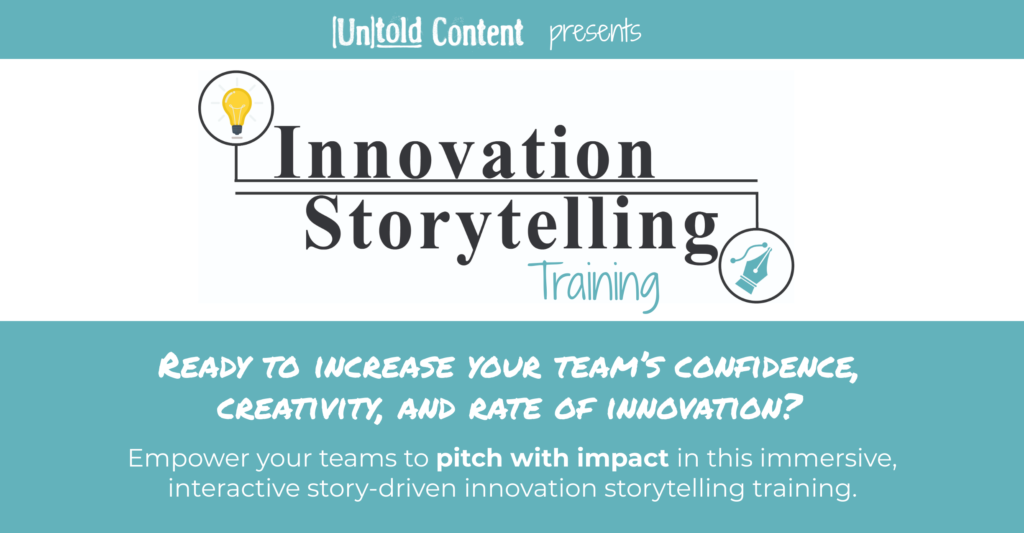
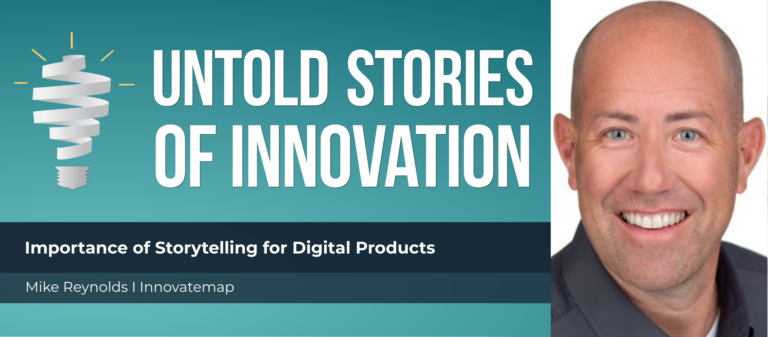
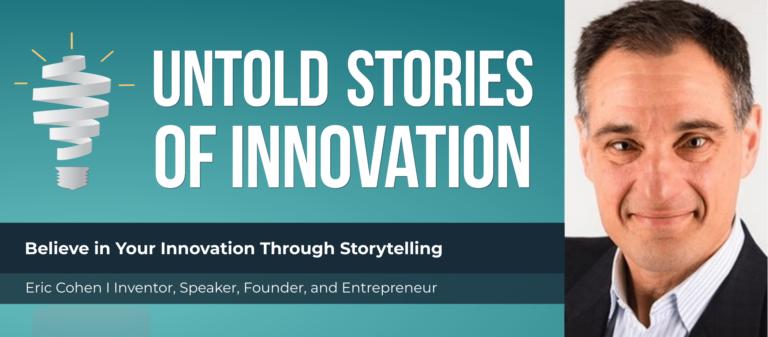
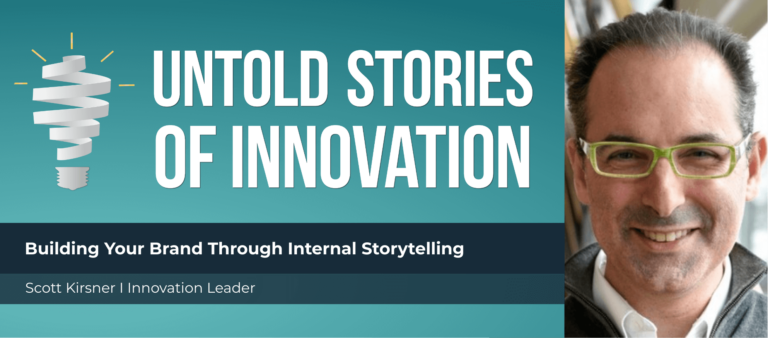
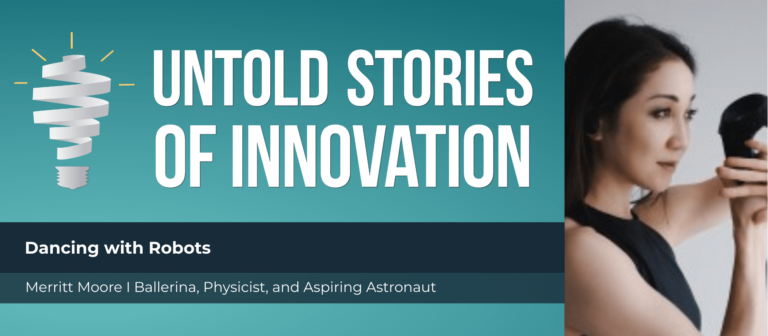

One Response
I’ve been all over this site looking for section for product users to leave comments, and Ms.Fish you seem to be The person! This is the first time in my 72 yrs that I’ve written to a company about one of their products but every time I use the new spray Powerwash Dawn, I just have to say “thankyou, thankyou, thankyou Proctor & Gamble people”!!! I’ve used Dawn not just for dishes, but as my mother and mother-in-law had told me years ago, “use Dawn to clean all of your cross stitch and needlepoint, and some of the regular sewing”. I wouldn’t trust my handiwork to any other cleaner. I LOVE the dish spray…..it’s a real KEEPER! Thanks again! Sheryll Harambasic